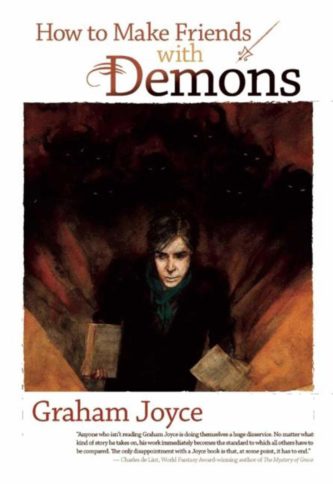 By GRAHAM JOYCE (Night Shade Books; 2008/09)
By GRAHAM JOYCE (Night Shade Books; 2008/09)
England’s Graham Joyce remains one of the great little-known horror writers, with superb novels like DREAMSIDE, THE TOOTH FAIRY and THE FACTS OF LIFE to his credit. HOW TO MAKE FRIENDS WITH DEMONS is one of Joyce’s most unique efforts, yet still contains many of the virtues of his more traditional novels, namely several well-rounded characters and a page-turning narrative.
The narrative though is where the book’s uniqueness is most evident. It’s a nontraditional character study centered on William Heaney, a middle-aged government worker who deals in fake antiquarian books—and who can see demons.
Demons as in shadowy nonhuman beings who ferment pettiness and evil. William, who narrates (and was actually credited with writing the novel in a previous edition), believes he can see these demons, and has personally identified 1,567 of the things. William also claims to have had personal contact with demons, having conducted a weird occult ritual in college that appears to have snuffed out the lives of several former girlfriends, and led to a nasty break-up that has haunted him ever since.
But I’m getting ahead of myself here. The narrative has numerous strands that advance concurrently, with flashbacks of William’s college-era exploits being one of them. Another concerns his present activities, which include preparing a forged first edition of PRIDE AND PREJUDICE, puzzling over the affections of a young woman who for some unfathomable reason seems interested in William, and dealing with the shocking deaths of two Gulf War veteran acquaintances. And then there are the demons, which are ever-present and not about to go away.
All of this initially seems disjointed, but Joyce gradually draws it all together into what turns out to be a carefully structured account. The beauty of it is that even when the book seems at its most chaotic it’s still a page turner. It has to do with the suppleness of Joyce’s prose, which is among the smoothest and most readable of any writer anywhere.
Getting back to the narrative of HOW TO MAKE FRIENDS WITH DEMONS, it also contains a plagiarized poem that provides the novel with its title, a “society of abandoned men” to which William belongs, and a somewhat lengthy manuscript by one of William’s war veteran pals. This latter element contains a passage about keeping one’s foot pressed to a landmine so it doesn’t blow up that takes on great symbolic significance, as does William’s forged book trade. He intones at one point that “No one needs to hang on to a first edition,” which of course has quite a few meanings, all of them relevant to William’s situation.
Thus we have a novel that’s witty, chilling and even profound—and every bit as complex and multi-faceted as its impeccably sketched protagonist.
